All published articles of this journal are available on ScienceDirect.
An IoT-driven COVID and Smart Health Check Monitoring System
Abstract
Introduction
The current global threat posed by the novel severe respiratory disease Corona Virus 2 is the most serious global public health disaster. The Internet of Things (IoT) is redefining innovative medical approaches. It is the progressing medical care frameworks from conventional by allowing patients to be more easily diagnosed, and checked.
Methods
In this paper, a convenient physiological scrutinizing groundwork is presented, which will allow us to continually monitor the patient's body temperature, blood oxygen level, saline levels, and respiration rate alongside cough detection. In both indoor and outdoor environments, note the temperature, humidity, and the position of any hazardous gasses.
Results
The data are saved on the web server, from which the person can access it from all over the world via an online connection.
Conclusion
We established a notification system for significant changes in sensor information via a web page, email, and SMS alerts with buzzer activation during an emergency.
1. INTRODUCTION
Coronavirus pandemic proliferation has affected the world more scathingly. The main plausible explanation for reducing its impact would be to reduce phases in the propagation and control of such illness [1-5]. The first and most effective way to minimize and handle the illness is to survey the Potential Infected Patient (PIP) in isolation by implementing the foreordained location in the given time frame. As vaccines are delayed in development and reach the market, this is only conceivable that with the help of IoT innovations, retrieving, checking, able to manage, and examining illnesses is possible remotely. Checking and controlling potentially infected COVID-19 patients continues to be a problem despite recent advances. Hence we have come up with a solution with IoT technology and WSN. This paper shows how an IoT-based approach enables efficient monitoring of the patient's health and environment, accompanied by a warning system in case of emergency. In this paper, a convenient physiological scrutinizing groundwork is presented, which will allow us to continually monitor the patient's body temperature, blood oxygen level, saline levels, and respiration rate alongside cough detection [6-8].
Due to the increasing awareness of the surroundings in which they have been residing during quarantine in recent days. In response, environmental monitoring systems must be developed that are reliable. A household application for an ecologic monitoring and control system exists. IoT technology is able to assist in meeting these demands. Our study suggests a conceptual architecture for the Internet of Things (IoT) that combines sensors, microcontrollers, and IoT technology to track environmental changes [9-13] efficiently. Using the stated module, people can check temperature, and humidity and identify the presence of noxious pollutants in both indoor and outdoor environments. Through an internet connection, the information stored on the web server is accessible to all users from all over the world. In the suggested technique, an application has been built to provide users with critical information. Users can also program alerts to be sent whenever there are significant changes in sensor data. The suggested system is accurate, affordable, and user-friendly when compared to other similarly related systems [14-18]. The proposed system is cloud-based, and data visualization modules allow easy monitoring.
The major contributions of this paper are:
• Demonstrates how an Internet of Things-based strategy allows for effective patient health and environmental monitoring, together with an emergency alert system.
• Created a system that would alert users to important changes in sensor data by email, SMS, and web page. In the event of an emergency, the buzzer would activate.
2. LITERATURE SURVEY
In this paper, a cost-efficient IoT framework with the help of various kinds of sensors, especially biosensors has been proposed to achieve the objective of monitoring the patient’s health status and environmental conditions as well. A messaging mechanism has also been implemented with the help of a cloud server and app interface [19]. In this paper, various motion sensors have been implemented along with the concept of Wireless sensor network protocol. Automation of doors has been an extra add-on to the paper, demonstrating a real-time life application with an assurance of safety and a good alerting system [20]. The primary component of the suggested here is the implementation of the Internet of Things gateway and Binary Synchronous Communications (BSC) Protocol. A location-tracking system with the help of sensors has been implemented via an IoT gateway [21-23]. This paper focuses on the respiratory system of the human body by demonstrating and implementing a multimodal patch sensor network for the respiratory system. It has also been found that the proposed methodology has led to the implementation of a cough detection system [24-27]. Unlike other proposed methodologies, in this paper, they have carried out their implementation with Raspberry Pi for obtaining vital parameters by integrating sensor technology and also incorporating a camera to monitor the physical status of the patient. In addition to that, they have invented a smart app/inventor/dash as well. The unique and new approach to cross-checking the data obtained from the patient with the help of viewing and analyzing the patient’s history has been proposed here. In addition to that, the proposed methodology comprises data from the COVID-19 RADAR Application, which makes use of a microcontroller and a communication module. A 3D model system interfaced with all the required sensors has been proposed to produce a wearable design prototype that will be quite simple to use and ease the use of infected patients as well. An API has been made to access the patient’s records and alert them in case of any emergency. In addition to that, real-time GPS data of the patient has also been carried out in this paper [28-31]. In order to screen for COVID-19, we employ quick and affordable Computed Tomography (CT) scan pictures [32]. A method is put forth for solving time-dependent partial differential equations that is explicitly unconditionally stable. The COVID-19 pandemic model is solved by applying the suggested scheme [33].
3. METHOD (PROPOSED METHODOLOGY)
In addition to proposing an alerting system for emergencies, the work attempts to demonstrate an IoT-based framework that can monitor the environment and the patient's health efficiently. In this context, our goal is to provide our research with a fully functional model that can be used to different scenarios. To begin with, the sensors are the input devices that will be used to collect all of the data from the patient's surroundings and the patient themselves. The Arduino code for the processing and analysis portion of the code will then be uploaded to the microcontroller, to which all of the data will be delivered . The Arduino IDE platform has been used to code in C. The Node MCU will play a significant role in addressing the cloud server and WiFi module required by our system. The patient's and the environment's status is continuously monitored by linking the data sent into the Arduino to the cloud server. Viewers can access all of the previously recorded sessions' history as well as any patient's information on a web page or web app. A power supply unit will be provided to the entire hardware configuration by means of an adapter. A software simulation with the help of Proteus has also been made to show a visual representation of our hardware setup. The buzzer is designed to inform caregivers, medical professionals, and anybody nearby to take care of the patient in the event that any of the measured metrics falls below the benchmark.
3.1. Node MCU (ESP8266)
Node MCU is an open-source platform that lets to share any data via Wi-Fi Protocol. This is mainly used in many IoT industrial fields and platforms, which are mainly useful in providing and extending the Wifi connectivity and this is a Lua-based firmware.
3.2. Arduino UNO
Arduino UNO is a microcontroller where the board is made up of AT Mega 328p. It is an open-source, easy-to-use programmable microcontroller board that is equipped with analog and digital pins. It is known for its exceptional connectivity and is user-friendly while dealing with works and experiments that require external power.
3.3. LM35
LM35 sensor is one of the temperature sensors where it is known for its precision integrated circuit design where the temperature can be measured in Celsius. For this type of sensor, there is no requirement for external calibration or trimming if there is any need to provide and obtain typical accuracies. Compared to a thermostat, LM35 can measure the temperature more accurately.
3.4. DHT11
DHT11 is a sensor that measures both the temperature and humidity of a given environment, which generates calibrated analog output. DHT11 may connect to a variety of microcontrollers, including Arduino, Raspberry Pi, and others. DHT11 is cost-efficient and offers excessive reliability and long-term stability. It measures the surrounding air with a humidity sensor and a thermistor and delivers the results as an analogue signal at the information pin.
3.5. Pulse Oximeter Sensor
A Pulse Oximeter sensor is a medical sensor that is used to measure the Peripheral oxygen saturation (SpO2) level and the heartbeat of the human body. It can be measured by placing the device, which has the pulse oximeter sensor interfaced on the patient’s finger where it will measure the oxygen saturation level and also the heartbeat of the person. These kinds of sensors are also known as medico sensors as it has been widely used in the field of medical industry. Oximeters work on the principle of spectrophotometry. It sends the infrared light into the capillaries of the human body to see the saturation level of the blood present.
3.6. MQ2 Sensor
Gas detectors can detect combustible, flammable, and poisonous gases, as well as oxygen shortage. This sort of equipment is extensively used in industry, and it may be found on oil rigs to monitor production processes and develop technologies such as photovoltaics. They may be used to put out flames. Monitoring of gases produced is critical in today's technological environment. Monitoring of gases is critical in everything from residential appliances like air conditioners to electric chimneys and safety systems in industries. Gas sensors respond to the presence of gas in a spontaneous manner, informing the system of any accumulation of particles in the gaseous phase. The gas sensing module consists of a metal carapace with a sensing unit.
3.7. Sound Sensor
A microphone and decoding circuits are included in the Sound Detector, which is a compact circuit board. It produces audio as well as a binary obvious sign of sound existence and an analogue depiction of its amplitude. A microphone and handling circuitry are included on the Sound Sensor, which is a small circuit. It generates audio as well as a binary sign of sound existence and an analogue depiction of its intensity. It distinguishes between sound and silence and generates a digital trigger signal. The trigger level of the digital signal can be adjusted. LEDs indicate the power and output signals.
3.8. IR Sensor
An infrared sensor is an electrical device that produces infrared light in order to detect specific environmental parameters. A sensor module can both detect motion and measure the temperature of an object. The phrase “silent Infrared sensor” relates to a sensor that measures rather than emits infrared radiation. It is no surprise that almost every item emits infrared radiation. These are undetectable to the human eye radiations that may be recognized by an infrared camera. The transmitter is a basic infrared LED, and the device is a basic infrared detector that absorbs infrared radiation of the same frequency as the Infrared Sensor. When IR light hits a photodiode, it induces its resistances and reference voltage to vary.
3.9. Solenoid Valve
An electromechanical valve otherwise known as a solenoid valve operated by an electric current passing through a solenoid is known as a solenoid valve. It may be used to control the flow of water and keep track of water levels. The benefits of solenoid value include fast and safe changing, good stability, high durability, good middle ground compliance of the components used, lower power energy, and compact design.
3.10. Buzzer
When activated, it is a physical, electromechanical, or piezoelectric signalling device that makes a sound. Buzzers and beepers are commonly used for alarm systems, clocks, and verification of human involvement, including a click of the mouse or keyboard. Buzzers are electrical actuators that require a DC power source and are often used in sound devices such as computers, scanners, copy machines, alarms, electronic toys, automotive electronic devices, cell phones, thermostats, and other electronic items. Active buzzer at 5 volts, the specialised sensor enlargement module and board in this part may complete a simple control circuit, providing for “programmable” operation, and rated power can be directly attached to a continuous sound.
4. PROPOSED SYSTEM
In Fig. (1), the block diagram represents the connection of our whole setup of the patient and environmental monitoring. The power supply is given to the Arduino UNO which acts as our microcontroller in our hardware model, to operate different mechanisms. SpO2 sensor, LM35 sensor, IR sensor, Sound sensor, DHT11 Sensor, and MQ2 Gas sensor are connected to the microcontroller i.e., Arduino UNO, to get input values and measurements for the parameters that need to be measured for monitoring the patient and environment. Along with that, the saline level is constantly measured with the help of an IR sensor. The main purpose of the solenoid valve is to stop the injection of saline into the patient’s body when the condition arises where the body temperature is less than the normal threshold value. To do the before said statement, a solenoid valve is placed to control the flow of injection of saline level. The Node MCU that we are using is the model ESP8266 which has an inbuilt Wifi module. This Node MCU is connected to the cloud server, which enables the doctor, caretakers, and patient to constantly check on the status condition of the patient’s health and the surroundings them and also whenever required. In addition to that, whenever the parameters that have been measured and monitored go to the stage of abnormal value, to alert the caretaker a buzzer has also been placed in case of emergencies.
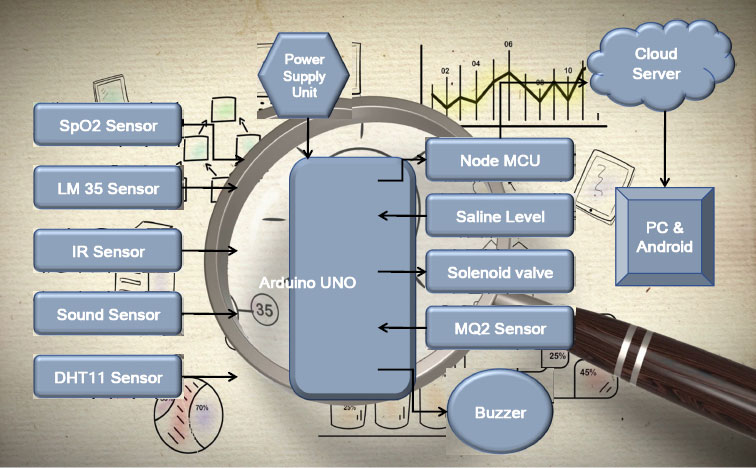

5. EXPERIMENTAL SETUP
Fig. (2) depicts the Hardware model set for both patients (may it be for COVID patients or general health care) & environment monitoring. The sensors are interfaced with the Arduino which is the microcontroller in the hardware model, where it will be receiving all the inputs from the sensors. The buzzer is kept for alerting in case of any emergencies or any help needed.
In this Fig. (3), we have represented three situations:
(i) The first two denote a load cell that is hung on a stand for saline water level monitoring and an IR sensor that is used for saline level monitoring.
(ii) The next parts, 3, 4, and 5 are for breathing & coughing monitoring mechanisms. Two sound sensors are placed on either side of the mask, one for Coughing detection & the other for breathing purposes. A microphone positioned over the neck can detect the fluctuation of sound and be used to assess respiratory sound. Frequency analysis and loudness estimate may be done using this information. The 6th one is a probe that is placed on the finger for SpO2 reading (which is responsible for showing the percentage of oxygen in human blood).
Simulating the proposed design at the beginning will allow you to verify its achievability, as well as the high level of efficiency of the control technique presented in Fig. (4). In Fig. (5), a basic model of the developed system with the help of Proteus software is displayed.
During the testing stage, a specific emphasis is put on the logical interims of the software to make sure that all statements are taken into account and a functional interim is completed to identify errors. Moreover, it makes sure that outputs are coordinated with the required ones based on the input. Several tests have been conducted both at the program and model levels and C programming language was successfully incorporated into the schematic, as shown in Fig. (6).
Simulation software simulated the performance of the real electronic device. A successful demonstration of circuit operation was performed with the Proteus software.
The Arduino code which has been compiled for the hardware model is shown in Fig. (7). The programming code is run on an Arduino IDE module that transfers to the microcontroller.

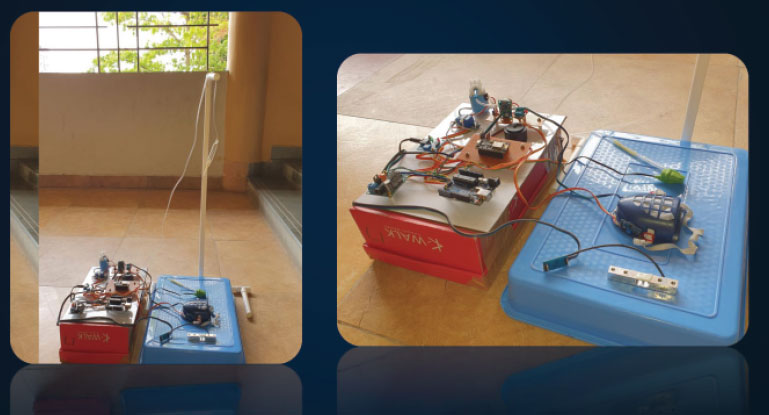
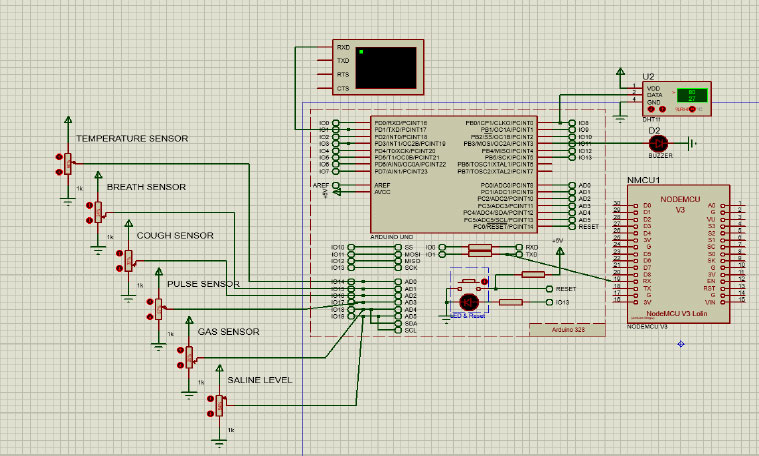
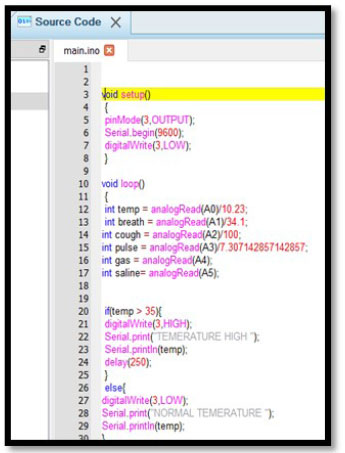


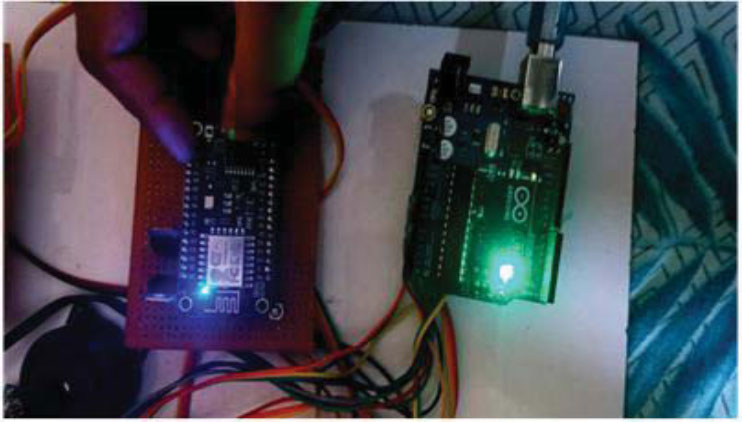
6. RESULTS & DISCUSSIONS
As shown in Figs. (8 and 9), the Arduino UNO and Node MCU both have been connected to the laptop to feed the code for our hardware setup. Both of the LEDs on the Node MCU and microcontroller are glowing, indicating that the code is being transmitted to the boards. The probe has been placed on the finger to measure the SpO2 level of the human body as shown in Fig. (8). Likewise, the breath cuff can be kept on the patient’s body to measure the breathing pattern and cough pattern. Likewise, the parameters measured for the human body, that is, body temperature, SpO2, Saline Level, Cough Pattern, and breathing pattern are monitored and are viewed on the web page and applications as shown in the figure. Similarly, for the environment, the temperature, humidity, and gas detection are monitored and viewed in the same way as well.
Figs. (10 & 11) are the web pages that we have created to survey the condition of the patient’s health and the environment as well. As you can see for the patient’s body, the following parameters have been measured:
• SpO2
• Body Temperature
• Saline Level
• Breathing Pattern
• Coughing Pattern
And for the environmental monitoring:-
• Room Temperature and Humidity
• Gas detection
In addition to that, the history and records of the previously monitored patients can also be viewed and used in the future if needed and can be analyzed for other health purposes as well (which is shown in the Fig. 12).
Furthermore, a native app has been created from the webpages as cited in Fig. (13). Mobile apps are being considered by healthcare organizations in order to provide quality service across borders.
This app is most likely a health management app that assists people in assessing their medical conditions, such as diabetes, mental wellbeing, cholesterol level, heart rate, and other attributes. It can easily track valuable patient's health data from system-connected devices or wearables. This allows doctors to create a thorough overview for each patient.
We designed this application, as shown in Fig. (13), with the idea that it has significant advantages over web pages, several of which are due to ease of access, offline usage, as well as mobility.
The application for Patient health and environment monitoring has successfully been developed and implemented, as shown in Fig. (14). The application has been built using PHP which is an open-source scripting language that could be used to build websites as well as any type of web-based app.
Fig. (15) depicts the output/results of the Software Simulation done in Proteus. According to the principle and structure of the circuit, the circuit diagram was drawn first. A . HEX file was then downloaded to the MCU to obtain the results of the simulation.
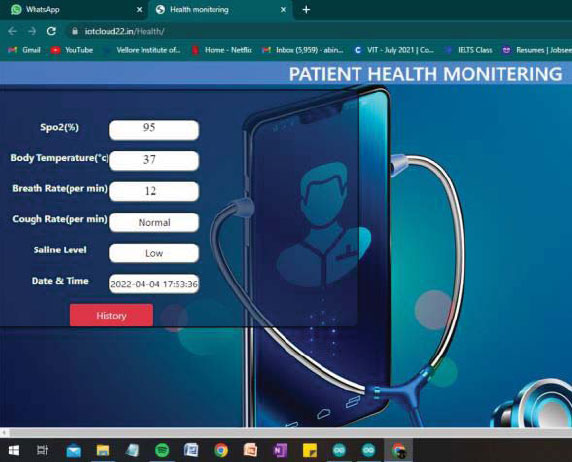
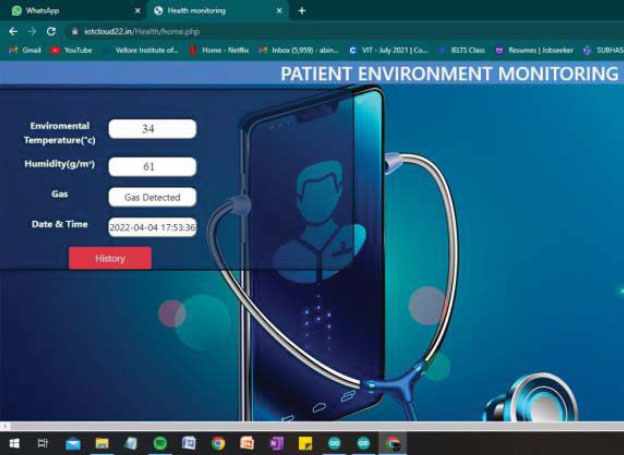
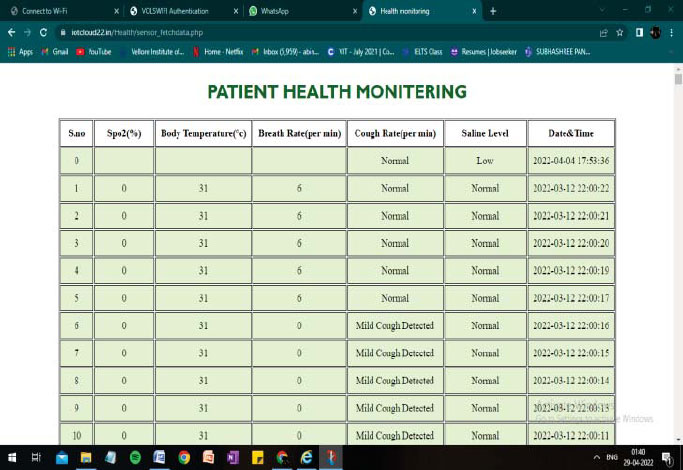
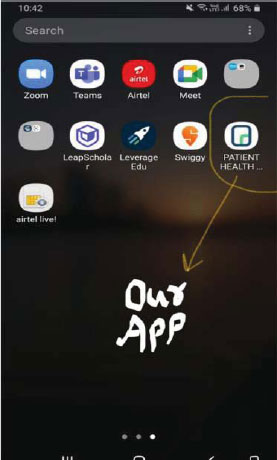
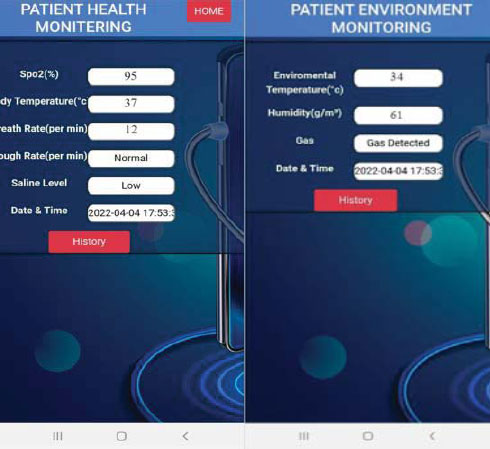
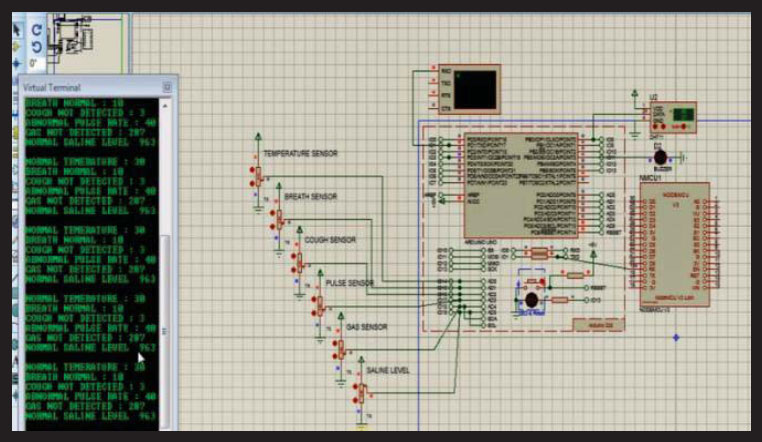
7. APPLICATIONS
Our paper can lead the way to many successful applications in various industries. This IoT framework can be useful by implying the same framework in Glucose monitoring systems using the implantation concept. This work deals with both general health and COVID as well, and the most important factor of COVID is the respiratory system in our paper, it measures the breathing and coughing pattern. Hence this can be used in the detection of any severe respiratory disease. The elderly, especially those who suffer from severe respiratory diseases, as well as those in rehab, can use this to treat many conditions, including Chronic Obstructive Pulmonary Disease (COPD) and asthma. IoT has been setting its trend in the Artificial intelligence field day by day. Hence, this framework can be useful for incorporation into medical care as well, also for situations where the caretakers who need to step out for a while or constantly monitor the patient for a particular period can use this framework with the addition of the implementation of the Location Tracking System. Our paper can also be further made into a wearable for people to use more efficiently and also promotes the concept of Telemedicine service and Self Service Medical Care.
8. FUTURE WORKS
In the future, this study will examine the framework in more detail, like monitoring other physiological parameters (e.g, gathering skin temperature with the help of optical and thermocouple sensors). Aside from the respiratory monitoring system, the framework can likewise be extended to incorporate a cardiovascular monitoring unit to escalate diagnostic feasibility. Likewise, we hope to amalgamate ML models to anticipate high-risk occasions and take brisk measures to augment treatment adequacy. Furthermore, the performance study can be conducted more comprehensively, using a variety of devices on more patients, to uncover what the system's limitations are. Support for quality supervision using real-time information will become more helpful with this technology.
Various other features include a Room Occupancy sensor that restricts the crowding in a room. This social distance alert notifies individuals if there is no maintaining safe distance between them, and a programmed hand sanitizer, which ensures sanitization without touching the tested individual, and so forth, can likewise additionally be integrated into the work, which will ultimately uphold general health awareness and ensures more security, and provides more effective smart surveillance of COVID-19 victims and deadly diseases to come in the upcoming year.
CONCLUSION
Every patient's life would be easier with the IoT-based real-time health monitoring framework because it would allow them to estimate various health parameters independently. To carry out clinical tests properly and to screen the patient's surroundings for signs of disease, an instrument uses five inputs from patients so that it displays data on a mobile phone application. The implementation will reduce patient wait times by creating immediate results. It's an affordable instrument that offers quick results, making it available to everyone. Although some of the results were obtained with unintentional errors, they can yet be improved in the future. Additionally, using the implementation is easy and safe. The devices shall be hooked up to an Alert System, which will notify the patient in case of abnormal clinical test results. Based on the results of this framework, patients can also be provided with feedback at an early stage.
In regards to the current pandemic, the three aspects considered during the implementation process are monitoring without risk of infections (remotely)and a single doctor sees 500 patients, and in an emergency, they receive immediate attention.
LIST OF ABBREVIATIONS
| IoT | = Internet of Things |
| SMS | = Short Message Service |
| LED | = Light-Emitting Diode |
| PIP | = Potential Infected Patient |
| BSC | = Binary Synchronous Communications |
| RADAR | = Radio Detecting and Ranging |
| GPS | = Global Positioning System |
| IDE | = Integrated Development Environment |
| SpO2 | = Peripheral Oxygen Saturation |
| COPD | = Chronic Obstructive Pulmonary Disease |
ETHICS APPROVAL AND CONSENT TO PARTICIPATE
Not applicable.
HUMAN AND ANIMAL RIGHTS
No animals were used for studies that are the basis of this research.
CONSENT FOR PUBLICATION
Not applicable.
AVAILABILITY OF DATA AND MATERIALS
The data and supportive information are available within the article.
FUNDING
None.
CONFLICT OF INTEREST
The authors declare no conflict of interest, financial or otherwise.
ACKNOWLEDGEMENTS
Declared none.


